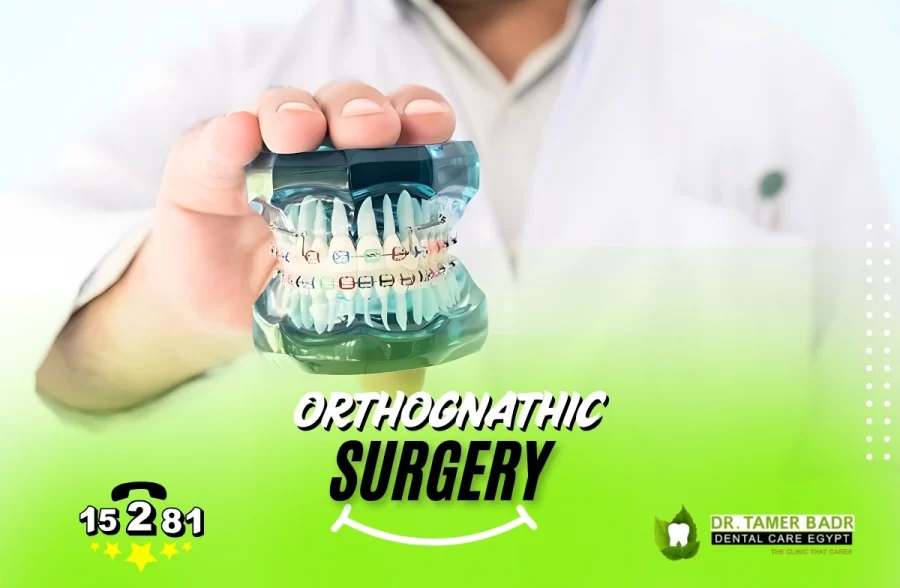
Orthognathic surgery, commonly referred to as corrective jaw surgery, is a specialized procedure aimed at addressing structural abnormalities of the upper and lower jaws. These discrepancies can lead to functional issues such as difficulties in chewing, speaking, and breathing, as well as aesthetic concerns related to facial symmetry.
The surgery involves repositioning one or both jaws to achieve proper alignment, thereby improving both function and appearance. Typically, this procedure is a collaborative effort between an oral and maxillofacial surgeon and an orthodontist, ensuring comprehensive care tailored to the patient’s specific needs. Orthognathic surgery is generally considered when non-surgical treatments are insufficient to correct jaw misalignments.
Types of orthognathic surgeries
Orthognathic surgery encompasses several procedures designed to correct jaw misalignments and enhance both function and facial aesthetics. The primary types include:
Maxillary Osteotomy (Upper Jaw Surgery): This procedure addresses issues such as an overdeveloped or underdeveloped upper jaw, open bites, or crossbites. By repositioning the maxilla, it improves facial harmony and dental function.
Mandibular Osteotomy (Lower Jaw Surgery): Used to correct protrusion or retrusion of the lower jaw, this surgery realigns the mandible to achieve proper bite alignment and facial balance.
Bimaxillary Osteotomy (Double Jaw Surgery): When both jaws are misaligned, this comprehensive approach adjusts the positions of both the upper and lower jaws simultaneously to correct complex skeletal discrepancies.
Genioplasty (Chin Surgery): Often performed alongside jaw surgeries, genioplasty modifies the chin’s shape or position to enhance overall facial symmetry.
Temporomandibular Joint (TMJ) Surgery: This procedure focuses on resolving disorders of the jaw joint, alleviating pain, and restoring normal movement, particularly in cases of arthritis or joint dysfunction.
The selection of the appropriate surgical approach depends on the individual’s specific anatomical and functional needs, as determined by a thorough clinical evaluation.
Cases requiring orthognathic surgery
Orthognathic surgery is indicated for patients with severe skeletal discrepancies that cannot be corrected with orthodontics alone, such as pronounced malocclusions—overbite, underbite, crossbite, or anterior open bite—facial asymmetry from dentofacial deformities like prognathism or retrognathism, transverse jaw discrepancies, and midface hypoplasia.
It is also used to treat obstructive sleep apnea when conservative methods fail, congenital anomalies such as cleft palate, chronic TMJ disorders causing pain and limited function, difficulty chewing or swallowing, speech articulation issues, and inability to achieve lip closure at rest.
Preparation Steps for Orthognathic Surgery:
Quit Smoking: Smoking increases surgical risks and slows healing. The sooner you quit, the better your outcome.
Complete Pre‑Surgical Orthodontic Treatment: Align teeth with braces or clear aligners to ensure proper occlusion during surgery.
Medical Evaluation & Anesthesia Clearance: Undergo blood tests and physician clearance to confirm fitness for surgery and general anesthesia.
Advanced Imaging & Surgical Planning: Obtain X‑rays, 3D CT scans, and dental impressions for precise mapping of bone cuts and implant positioning.
Discontinue Blood Thinners: Stop medications like aspirin and NSAIDs at least two weeks before surgery to reduce bleeding risk.
Arrange Recovery Logistics: Schedule time off work or school, organize transportation home, and ensure you have caregiver support for the initial recovery period.
Prepare a Soft‑Food Diet: Stock up on nutritious, easy‑to‑chew foods to follow dietary restrictions and aid comfortable healing.
Stages of surgery
Orthognathic surgery involves a series of carefully coordinated steps to correct jaw misalignments and improve both function and facial aesthetics. Here’s an organized overview of the typical surgical process:
1- Anesthesia Administration
The procedure begins with the administration of general anesthesia to ensure the patient remains unconscious and pain-free throughout the surgery.
2- Intraoral Incisions
Surgeons make incisions inside the mouth to access the jawbones, minimizing visible scarring.
3- Osteotomy (Bone Cutting)
Depending on the specific case, the surgeon performs precise cuts in the jawbones:
- Maxillary Osteotomy (Le Fort I): Adjusts the upper jaw’s position.
- Mandibular Osteotomy (Bilateral Sagittal Split): Repositions the lower jaw.
- Genioplasty: Modifies the chin’s shape or position.
4- Repositioning of Jaw Segments
The jaw segments are carefully moved to their new, planned positions to achieve proper alignment and occlusion.
5- Fixation
The repositioned bones are stabilized using titanium plates and screws to maintain their new alignment during healing.
6- Closure of Incisions
The intraoral incisions are closed with sutures, and care is taken to ensure minimal postoperative discomfort.
7- Postoperative Care
After surgery, patients are monitored during recovery, and specific instructions are provided to facilitate healing, including dietary guidelines and oral hygiene practices.
Each surgical plan is tailored to the patient’s unique anatomical needs and desired outcomes. Advancements in surgical techniques and planning have enhanced the precision and safety of orthognathic procedures.
Recovery period after orthognathic surgery
Recovery from orthognathic surgery is a gradual process that varies among individuals, influenced by factors such as the complexity of the procedure, the patient’s overall health, and adherence to post-operative care instructions. Here’s a general timeline outlining the stages of recovery:
1- Immediate Post-Operative Period (Days 1–2):
- Swelling and discomfort are most pronounced during the first 48 hours.
- Patients are typically monitored in the hospital or surgical facility during this time.
- A liquid or soft diet is initiated to minimize jaw movement
2- First Week (Days 3–7):
- Swelling may peak around day 3 and then gradually decrease.
- Pain and discomfort are managed with prescribed medications.
- Maintaining proper oral hygiene is crucial to prevent infection.
3- Weeks 2–4:
- Swelling and bruising continue to subside.
- Patients may transition to a soft or semi-solid diet as tolerated.
- Light activities can usually be resumed, but strenuous exercise should be avoided.
4- Weeks 5–8:
- Most patients can return to work or school during this period.
- Diet can be gradually expanded to include more solid foods, depending on comfort and healing progress.
- Follow-up appointments are essential to monitor healing and make any necessary orthodontic adjustments.
5- Months 3–6:
- Continued improvement in jaw function and appearance.
- Any residual swelling typically resolves.
- Final orthodontic treatments may be completed to refine bite alignment.
6- Up to 12 Months:
- Complete healing of the jawbones and surrounding tissues.
- Final results, both functional and aesthetic, become fully apparent.
It’s important to note that individual recovery experiences may vary. Adhering to your surgeon’s post-operative instructions, maintaining good nutrition, and attending all follow-up appointments are key factors in ensuring a smooth and successful recovery.
Potential risks and complications of orthodontic surgery
1- Nerve Injury and Numbness
- Temporary numbness in areas such as the lower lip, chin, or cheeks is common due to manipulation of nerves like the inferior alveolar nerve.
- While most cases resolve within weeks to months, permanent sensory changes can occur in rare instances.
2- Infection
- Postoperative infections may develop at the surgical site, potentially requiring antibiotics or additional interventions.
- The risk of infection is minimized through sterile surgical techniques and proper postoperative care.
3- Bleeding and Hematoma
Some bleeding during and after surgery is expected; however, excessive bleeding or hematoma formation may necessitate medical attention.
4- Relapse or Unintended Jaw Movement
In some cases, the jaw may gradually shift back toward its original position, especially if postoperative guidelines are not strictly followed.
5- Temporomandibular Joint (TMJ) Disorders
Surgery can sometimes exacerbate or lead to TMJ issues, resulting in jaw pain, clicking, or difficulty in movement.
6- Sinus Complications
Procedures involving the upper jaw may affect the sinus cavities, potentially leading to sinus infections or discomfort.
7- Unfavorable Aesthetic Outcomes
Despite meticulous planning, some patients may be dissatisfied with the cosmetic results, possibly requiring revision surgery.
8- Damage to Teeth or Dental Roots
Adjacent teeth or their roots may be injured during surgery, potentially leading to sensitivity or the need for further dental treatment.
9- Airway Changes and Sleep Apnea
Alterations in jaw structure can impact airway dimensions, occasionally leading to or worsening obstructive sleep apnea.
10- Delayed Bone Healing or Nonunion
In rare cases, the jawbones may heal slowly or fail to unite properly, necessitating additional surgical intervention
While these complications are relatively uncommon, it’s crucial to discuss them with your surgical team. Adhering to preoperative and postoperative instructions, attending follow-up appointments, and maintaining good oral hygiene can significantly reduce the risk of adverse outcomes.
11- Benefits of orthognathic surgery
Orthognathic surgery offers a range of functional, aesthetic, and psychological benefits for individuals with jaw misalignments or facial skeletal discrepancies. Here are some key advantages:
- Improved Bite and Chewing Function Correcting jaw alignment enhances the ability to bite and chew efficiently, reducing strain on the jaw muscles and teeth.
- Enhanced Speech Clarity Jaw misalignments can affect speech patterns. Surgical correction can lead to clearer articulation and improved speech.
- Alleviation of Jaw Pain and Discomfort By addressing structural issues, the surgery can relieve chronic jaw pain and temporomandibular joint (TMJ) disorders.
- Improved Facial Aesthetics Repositioning the jaws can enhance facial symmetry and balance, leading to a more harmonious appearance.
- Better Breathing and Sleep Quality For individuals with obstructive sleep apnea or breathing difficulties, orthognathic surgery can open the airway, improving breathing during sleep.
- Enhanced Oral Health Proper jaw alignment reduces abnormal wear on teeth and helps maintain better oral hygiene, decreasing the risk of cavities and gum disease.
- Boosted Self-Confidence Improvements in function and appearance often lead to increased self-esteem and confidence in social and professional settings.
These benefits contribute to an overall improvement in quality of life for patients undergoing orthognathic surgery. It’s important to consult with a qualified oral and maxillofacial surgeon to determine if this procedure is appropriate for your specific needs.
Tips for Choosing the Right Orthognathic Surgeon
Verify Board Certification and Credentials: Ensure the surgeon is board-certified in oral and maxillofacial surgery, indicating they have completed rigorous training and examinations. Board certification demonstrates a commitment to maintaining high standards in the field .
Assess Experience with Orthognathic Procedures: Inquire about the surgeon’s experience specifically with orthognathic surgeries. A surgeon who regularly performs jaw correction procedures is more likely to be adept at handling complex cases and anticipating potential complications .
Review Patient Testimonials and Before-and-After Photos: Look for reviews and testimonials from previous patients to gauge satisfaction levels. Additionally, before-and-after photos can provide insight into the surgeon’s skill and the results you might expect.
Evaluate Communication and Comfort Level: A good surgeon should communicate clearly, answer all your questions, and make you feel comfortable throughout the consultation process. Effective communication is essential for understanding the procedure and setting realistic expectations .
Consider the Surgical Facility and Technology: Ensure that the procedure will be performed in an accredited facility equipped with modern technology. Advanced equipment can enhance the precision and safety of the surgery .
Discuss Financial Aspects and Insurance Coverage: Orthognathic surgery can be a significant investment. Discuss the total cost, payment plans, and whether the surgeon accepts your insurance. Understanding the financial aspects upfront can prevent unexpected expenses later on .
Seek Referrals from Trusted Sources Ask your general dentist, orthodontist, or primary care physician for recommendations. Healthcare professionals can often refer you to reputable surgeons with proven track records .
While the journey involves thorough planning and a commitment to recovery, the long-term benefits—ranging from improved oral health to boosted self-confidence—are substantial. If you’re considering this path to a better quality of life, consulting with a qualified oral and maxillofacial surgeon can provide personalized insights and guide you toward achieving optimal results.

